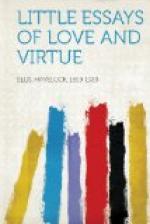It is thus that we arrive at the importance of the play-function, and thus, also, we realise that while it extends beyond the sexual sphere it yet definitely includes that sphere. There are at least three different ways of understanding the biological function of play. There is the conception of play, on which Groos has elaborately insisted, as education: the cat “plays” with the mouse and is thereby educating itself in the skill necessary to catch mice; all our human games are a training in qualities that are required in life, and that is why in England we continue to attribute to the Duke of Wellington the saying that “the battle of Waterloo was won on the playing fields of Eton.” Then there is the conception of play as the utilisation in art of the superfluous energies left unemployed in the practical work of life; this enlarging and harmonising function of play, while in the lower ranges it may be spent trivially, leads in the higher ranges to the production of the most magnificent human achievements. But there is yet a third conception of play, according to which it exerts a direct internal influence—health-giving, developmental, and balancing—on the whole organism of the player himself. This conception is related to the other two, and yet distinct, for it is not primarily a definite education in specific kinds of life-conserving skill, although it may involve the acquisition of such skill, and it is not concerned with the construction of objective works of art, although—by means of contact in human relationship—it attains the wholesome organic effects which may be indirectly achieved by artistic activities. It is in this sense that we are here concerned with what we may perhaps best call the play-function of sex.[19]
[19] The term seems to have been devised by Professor Maurice Parmelee, Personality and Conduct, 1918, pp. 104, 107, 113. But it is understood by Parmelee in a much vaguer and more extended sense than I have used it.
As thus understood, the play-function of sex is at once in an inseparable way both physical and psychic. It stimulates to wholesome activity all the complex and inter-related systems of the organism. At the same time it satisfies the most profound emotional impulses, controlling in harmonious poise the various mental instincts. Along these lines it necessarily tends in the end to go beyond its own sphere and to embrace and introduce into the sphere of sex the other two more objective fields of play, that of play as education, and that of play as artistic creation. It may not be true, as was said of old time, “most of our arts and sciences were invented for love’s sake.” But it is certainly true that, in proportion as we truly and wisely exercise the play-function of sex, we are at the same time training our personality on the erotic side and acquiring a mastery of the art of love.




